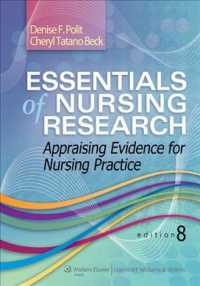Full Description
A Training Guide for College Tutors and Peer Educators presents relevant and research-based methods for successful academic support sessions for tutors and peer educator trainees in an adaptable, user-friendly, and interactive format.
By mirroring appropriate methods for organizing and presenting material in an academic support session, it allows the reader to experience for themselves the practices and strategies they will apply as future tutors and peer educators. Based on solid learning theory, the activities, assessments, examples and features included in this flexible and engaging text simulate recommended peer educator practices and emphasize guiding college students to become active, self-monitoring and independent learners.
While teaching readers the key, research-based elements of quality peer assistance, this first-edition guide also incorporates a comprehensive list of topics represented in certification programs. Peppered with practical examples and interactive problem-solving scenerios that readers can immediately apply in their positions, trainees will learn how to plan for sessions, how to assess students' learning, how to create collaborative activities, how to integrate college learning strategies, and how to approach common issues faced on the job.
Contents
Preface
Chapter 1 - The Power of Peers: Your Role as a Peer Educator
Opening: Focus Questions
What is a Peer Educator?
Role of a Peer Educator
Activity 1.1: Andragogy and Peer Assistance
Facilitator of Learning
Peer Educator's Role and Development of Students
Benefits for You, the Peer Educator
Activity 1.2: Interviewing
Learning Strategy: Managing Your Time
Activity 1.3: Assess Your Time Management Skills
Strategies for Improving Time Management
Setting Goals
Activity 1.4: Personal Goal
Closing
Activity 1.5: Check Your Understanding
Activity 1.6: Elements of Effective Peer-Led Sessions
Suggestions from Experienced Peer Educators
How do you incorporate learning and study strategies?
Chapter 2 - Promoting Active Learning
Opening: Focus Questions
Active Learning
Activity 2.1: Promoting Active Learning
How Learning Occurs
Information Processing Model
Activity 2.2: Information Processing and Learning Strategies
Activity 2.3: Applying the Information Processing Model
Differences in Learning
Visual, Auditory, Tactile/Kinesthetic Preferences
Activity 2.4: Assessing Learning Modalities
Activity 2.5: Analyzing Learning Modalities
Personality Type
Activity 2.6: Assessment
Description of the Dimensions
Activity 2.7: Reflecting
Activity 2.8: Learning Preferences and Learning Strategies
Closing
Activity 2.9: How do you learn best?
Activity 2.10: Checking for Understanding
Activity 2.11: Applying
Suggestions from Experienced Peer Educators
How do you increase active participation?
Chapter 3 - Incorporating Critical Thinking and Questioning Skills
Opening: Reading Textbooks
Activity 3.1: Practice Previewing
Introduction
Talk Out Loud
Activity 3.2: Practice Cognitive Process Instruction
Include Questions
Activity 3.3: Integrating Questions in Sessions
Activity 3.4: Observing
Include Higher-Level Directives
Activity 3.5: Directive Words
Activity 3.6: Critiquing
Closing
Activity 3.7: Analyzing
Activity 3.8: Elements of Effective Peer-Led Sessions
Suggestions from Experienced Peer Educators
How do you encourage critical thinking?
Chapter 4 - Assessing Students' Learning
Opening: Self-Assessment
Why Assess Students' Learning?
Activity 4.1: Reflecting
How to Assess Students' Learning?
Beginning of Session
Activity 4.2: Assessment Example
Middle of Session
Activity 4.3: Try it Out
End of Session
Activity 4.4: Thinking and Assessing
What Is and Is Not Adequate Evidence of Learning?
Activity 4.5: Observation
Closing
Activity 4.6: Practice Summative Assessment
Learning Strategy: Preparing for Exams
Activity 4.7: Exam Preparation
Activity 4.8: Summarizing Important Information
Suggestions from Experienced Peer Educators
How do you assess students' understanding?
Chapter 5 — Collaborative Learning and Group Work
Opening: Predicting
Collaborative Learning
Activity 5.1: Examples of Collaborative Learning
Collaborative Learning Guidelines
Group Configurations
Activity 5.2: Observing
Dealing with Common Problems
Activity 5.3: Responding to Problems
Planning Sessions
Activity 5.4: Plan a session
Closing
Learning Strategy: Graphic Organizers
Activity 5.5: Collaborative Graphic Organizer
Activity 5.6: Check for Understanding
Suggestions from Experienced Peer Educators
How do you create collaboration among students?
Chapter 6 - Tutoring as a Proactive Process
Opening: Highlighting and Annotating
Activity 6.1: Guidelines
Activity 6.2: Applying
Introduction
A Proactive Model
Activity 6.3: Reflection
The Tutoring Cycle
Step I. Assess the Student's Needs
Activity 6.4: Assessing a Student's Needs
Step II. Recommend, Demonstrate, and Apply
Activity 6.5: Try it Out
Step III. Break Down Content; Evaluate Learning
Activity 6.6: Tutoring Strategies
Step IV. Plan for Application
Activity 6.7: Evaluate Student Responses
Step V. Follow Up
Activity 6.8: Tutoring Cycle: Observing and Practicing
Active Listening
Activity 6.9: Reflecting
Activity 6.10: Active Listening Strategies
Activity 6.11: Verbal and Nonverbal Cues
Verbal Communication
Activity 6.12: Practice Verbal Communication
Guidelines for Verbal Communication
Activity 6.13: Active Listening and Verbal Communication
Closing
Activity 6.14: Follow up— Highlighting and Annotating
Chapter 7 — Valuing Diversity Among Students
Opening: Listening and Note Taking
Activity 7.1: Note Taking Strategies
Thinking About Diversity
Individual Activity 7.2: Reflecting
Group activity 7.3: Brainstorming
Group activity 7.4: Creating a Venn Diagram
Individual activity 7.5: Predicting
Overview
Dealing with Differences
Activity 7.6: Identifying Similarities and Differences
Guidelines for Peer Leaders
Activity 7.7: Case Studies
Resources for Referral
Activity 7.8: Role-playing Scenarios
Closing
Stereotypes and Biases
Activity 7.9: Different Perspectives
Conclusion
Suggestions from Experienced Peer Educators
How do you create a welcoming setting?
Chapter 8 — Online Assistance
Opening: Learning Discipline-Specific Terminology
Procedure for Learning Terminology
Activity 8.1: Chapter Terms
Adjustments for Online Assistance
Preparation
Activity 8.2: Summarize and Apply
Synchronous vs. Asynchronous
Activity 8.3: Summarize and Apply (cont'd.).
Communication
Activity 8.4: Summarize and Apply (cont'd.)
Activity 8.5: Summarize and Apply (cont'd.)
Activity 8.6: Critique an Online Dialogue
Learning and Study Strategies
Activity 8.7: Summarize and Apply (cont'd.)
Community
Activity 8.8: Summarize and Apply (cont'd.)
Closing
Assessment
Activity 8.9: Summative Assessment
Chapter 9 - Effective Peer-Led Sessions: A Summary
Summation
Activity 9.1: Top-ten List
Self Assessment
Activity 9.2: Revisiting Your Role in Students' Development
Self-Assessment
Activity 9.3: Self Assessment
Conclusion
Suggestions from Experienced Peer Educators
What can you do with an empty box?








